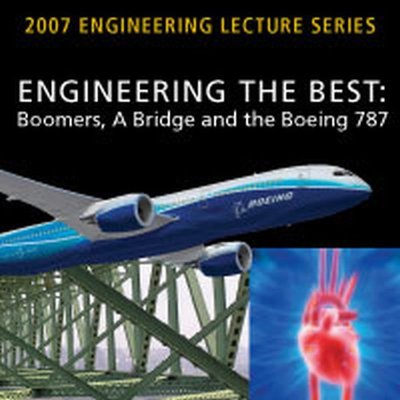October 18, 2007
Boeing 787 Dreamliner, Tacoma Narrows Bridge, baby boomers headline Engineering Lecture Series
Over the next month, the Engineering Lecture Series will look at how UW engineers are inventing technologies to build greener airplanes, enable a car to cross more than a mile of churning water, and even build replacement parts for aging bodies. All talks begin at 7 p.m. and take place in Kane Hall. The lectures are free and open to the public, but audience members are asked to register in advance.
The series kicks off Oct. 23 with Rebuilding the Baby Boomer: Replacement Parts for the 21st Century — a lighthearted look at the emerging field of engineering body parts. Buddy Ratner, professor of bioengineering and director of the UW Engineered Biomaterials, will describe the science behind a real-life bionic woman or man. Engineers are developing materials to grow new human tissue, build entire organs, target drug delivery and even use the brain to control artificial limbs.
“The number of Americans aged 65 and older will more than double by 2030,” Ratner said. “We wear out, get diseases or injuries. Medical implants and tissue engineering are tantalizing possibilities for enjoying the ‘golden years’ with vitality and good quality of life.”
The talk will provide an overview of the field, focusing on research being conducted in UW labs.
On Nov. 1, UW engineering alumnus Steven Hansen, now senior vice president of Kiewit Corp., will join Joe Mahoney, professor of civil and environmental engineering, to tell the story of the recently completed Tacoma Narrows Bridge. The Puget Sound region is famed for its floating bridges — and infamous for the collapse of Galloping Gertie, the first bridge, which collapsed in 1940. This lecture will devote most of the time to the new, mile-long suspension bridge.
“When you look at the engineering that went into building that bridge, it’s absolutely stunning,” Mahoney said. The cable used in the bridge could circle the globe twice. He described the lecture as “extremely visual,” using pictures and animations to tell the story of sinking pilings into deep, fast-moving water and building towers that reach 510 feet tall.
“They’ll see the challenges associated with building a great world bridge,” Mahoney said.
The final lecture, Building the Future of Commercial Aviation: Boeing’s 787 Dreamliner, is an inside look at how and why Seattle engineers are building what’s being described as the first plastic airplane.
On Nov. 13, join Al Miller, director of 787 technology integration at Boeing, and Mark Tuttle, chair of mechanical engineering and director of the Federal Aviation Administration’s Center of Excellence for Advanced Materials in Transport Aircraft Structures, for the story behind the revolutionary Dreamliner 787. Learn why Boeing is developing the 787, what makes it different, and how the use of composites promises to change the flying experience.
“The 787 is the first transport aircraft in which composites are used extensively in the load-bearing structures,” Tuttle said. “Composites are likely to be used more and more,” he added, because lightweight materials let the jet travel faster and burn less fuel, allowing air travel to be more energy efficient.
The 2007 Engineering Lecture Series: Engineering the Best will be broadcast on UWTV and available as a Webcast at www.uwtv.org. The series is co-sponsored by the College of Engineering and the UW Alumni Association.
Register online <a href=https://go.washington.edu/uwaa/events/2007eng_lectures/details.tcl>here</a>, or by phone at 206-543-0540. The Oct. 23 and Nov. 13 lectures will be held in 120 Kane; the Tacoma Narrows lecture will take place in 130 Kane.



